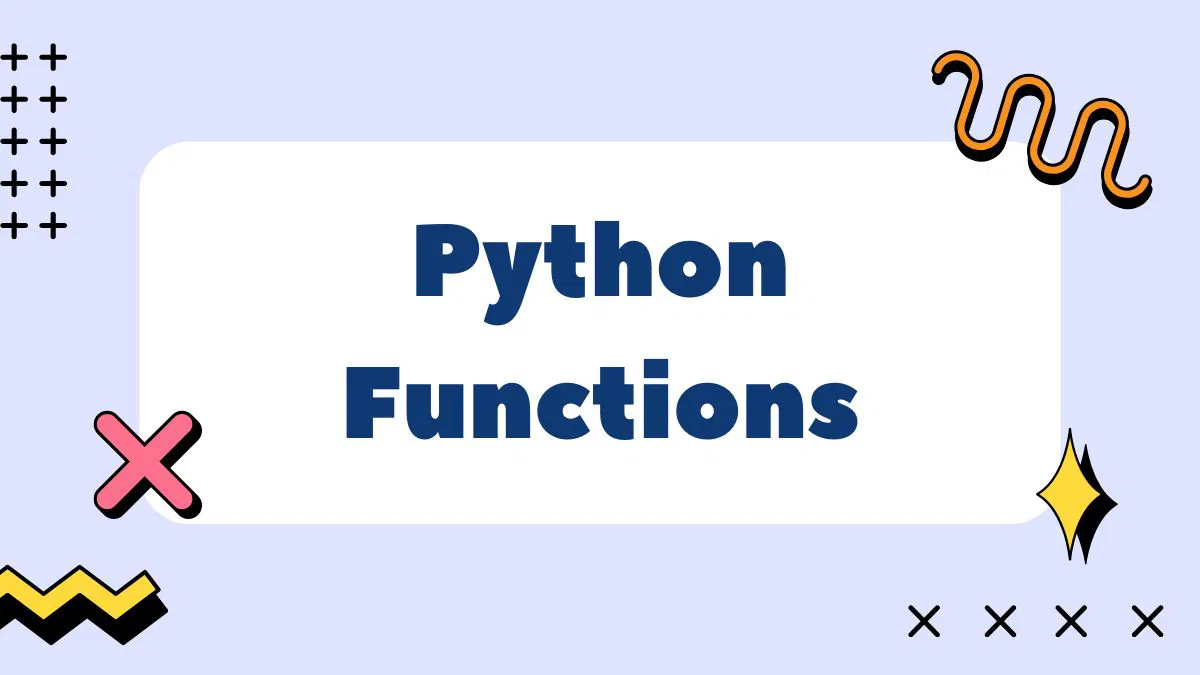Functions in python are one of the most important building blocks of programming. They make code reusable, organized, and easier to understand. Instead of writing the same piece of code repeatedly, you can define a function once and use it whenever needed. Whether you’re analyzing data, building a web app, or writing automation scripts, understanding how functions work in Python is essential for writing clean, efficient programs.
Table of Contents
What Are Functions in Python?
A function in Python is a block of reusable code designed to perform a specific task. Functions take input (called parameters), process it, and return an output (called the return value). They allow developers to break complex problems into smaller, manageable parts improving readability and debugging.
Python comes with many built-in functions like len(), max(), and print(), but you can also create user-defined functions to meet your own program’s needs.
Syntax of a Functions in Python
The basic syntax for defining a function in Python is simple and easy to remember.
Syntax:
def function_name(parameters):
# function body
return value
Example:
def greet(name):
return f"Hello, {name}!"
When you call greet("Zain"), it returns “Hello, Zain!”.
You can learn more about function syntax on the official Python documentation.
Types of Functions in Python
Python provides two broad categories of functions:
- Built-in Functions – Predefined in Python, like
abs(),sum(), andlen(). - User-defined Functions – Created by developers for specific tasks.
Let’s explore each type in more detail.
Built-in Functions in Python
Python includes a wide range of built-in functions that perform common operations. For example:
numbers = [10, 20, 30]
print(len(numbers)) # returns 3
print(sum(numbers)) # returns 60
print(max(numbers)) # returns 30
You can explore the full list of built-in functions at Python’s built-in function reference.
User-defined Functions
User-defined functions let you create custom logic:
def add(a, b):
return a + b
Calling add(3, 5) returns 8. Functions like this make your code modular and reusable.
Function Arguments and Parameters
Functions in Python can take inputs in different ways. There are four major types of arguments:
- Positional Arguments: Passed in order.
def multiply(a, b): return a * b print(multiply(2, 3)) - Keyword Arguments: Named when called.
print(multiply(a=4, b=5)) - Default Arguments: Have preset values.
def greet(name="Guest"): print("Hello,", name) greet() # uses default - Variable-Length Arguments: Handle multiple inputs.
def show_names(*names): for n in names: print(n) show_names("Ali", "Sara", "John")You can also use**kwargsto pass key-value pairs as arguments.
Return Statement
A function can return data using the return keyword. This allows the result of a function to be stored or used later.
Example:
def square(num):
return num ** 2
result = square(4)
print(result)
If no return statement is provided, Python automatically returns None.
Scope and Lifetime of Variables
Variables defined inside a function are local, meaning they exist only while the function runs. Variables outside a function are global.
Example:
x = 10 # global
def show_value():
x = 5 # local
print("Inside:", x)
show_value()
print("Outside:", x)
Output:
Inside: 5
Outside: 10
Use the global keyword when you want to modify a global variable inside a function.
Lambda (Anonymous) Functions
Python also supports lambda functions small, one-line functions that don’t need a name.
Example:
square = lambda x: x * x
print(square(5))
These are useful for short operations, especially with functions like map() or filter().
Example:
numbers = [1, 2, 3, 4]
squared = list(map(lambda x: x**2, numbers))
print(squared)
Learn more about lambda functions on W3Schools.
Recursion in Functions
A function can call itself this concept is known as recursion. It’s often used for solving problems like factorial or Fibonacci sequences.
Example:
def factorial(n):
if n == 1:
return 1
else:
return n * factorial(n - 1)
Calling factorial(5) will return 120. Be cautious recursive functions must always have a base case to avoid infinite loops.
Docstrings and Function Documentation
Python allows you to add docstrings (documentation strings) inside your functions. This helps explain what the function does.
Example:
def greet_user(name):
"""This function greets the user by name."""
print(f"Hello, {name}!")
You can access this documentation using help(greet_user) in your console. Proper documentation improves readability and aligns with Python’s best coding practices (PEP 257).
Best Practices for Using Functions
- Keep functions short and focused on a single task.
- Use descriptive names like
calculate_total()orfind_average(). - Document each function using docstrings.
- Avoid global variables — use parameters instead.
- Always test functions independently for correctness.
Conclusion
Functions are essential for writing clean, scalable, and reusable Python code. They help you organize your logic into manageable pieces and make your programs more readable and maintainable. Understanding parameters, return values, lambda expressions, and recursion gives you a solid foundation for real-world development. Whether you’re building a data pipeline, a web application, or a machine learning model, mastering functions is a must. For a deeper dive into advanced topics like decorators, closures, and async functions, check out the Python Functions Tutorial on Real Python.
Also Check Loops in Python – Ultimate Comprehensive Guide – 2025


1 thought on “Functions in Python – Comprehensive Guide – 2025”